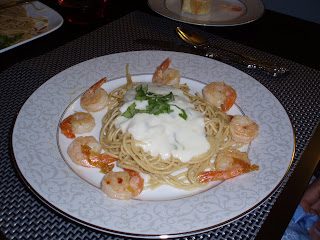Even as a child, one of my most favorite vegetables was Bhindi (okra, lady fingers). My mom would make this really quick version with lots of sliced onion and tomato, sautéed with the bhindi and just a few spices. It was delicious and when I was old enough to cook, it was one of the things I often made.
So before I give you the recipe, let me back track and explain the title of this post. Bhindi ki Bhujya, bhindi is okra and bhujya is an Urdu term used to describe any sautéed vegetables. So be it allu (potato), baingan (eggplant), gobi (cauliflower), etc. they can all be made in to bhujya's. If you remember in one of my first posts on cooking basics I explained how sabzi's (vegetables) are made in to "bhujya" or added to meat and form "saalan" (curry's/gravy). I also explained what bhagaar is and how it works as either a base or garnish. You will need these tips make this recipe...
 You will need:
You will need:
1 medium onion sliced
1 tbsp zeera (cumin seeds)
2 to 3 sabuth laal mirch (dried whole red chili)
1 tsp garlic paste
1/4 to 1/2 of a lemon or lime
1 to 2 Roma tomatoes diced
salt (to taste)
1 bag frozen (cut) bhindi or about 4 cups chopped fresh bhindi
In a large skillet, prepare your bhagaar... heat some oil then add the zeera and laal mirch. Wait till the zeera starts to get some color and add in the onion. Over high heat sauté until the onion starts to get translucent. Add in the garlic paste, bhindi, salt and lemon/lime. Sauté for a few minutes until all of the ingredients are mixed well. Add in the tomatoes, stir and cover. Lower the heat to medium or medium low and let cook until the tomato starts dissolving. Turn/stir the bhindi a few times during the process to ensure even cooking. Once the tomatoes have dissolved, uncover and sauté until there is no water/liquid remaining. There should be some juice in the vegetables (onion, bhindi, etc) but the mix should be fairly dry. But be careful! Do not overcook and dry out your vegetables...

That's it! Simple and quick :) Hope you'll enjoy this bhujya as much as I do... it’s very nutritious and tastes good too. Happy cooking!!!
So before I give you the recipe, let me back track and explain the title of this post. Bhindi ki Bhujya, bhindi is okra and bhujya is an Urdu term used to describe any sautéed vegetables. So be it allu (potato), baingan (eggplant), gobi (cauliflower), etc. they can all be made in to bhujya's. If you remember in one of my first posts on cooking basics I explained how sabzi's (vegetables) are made in to "bhujya" or added to meat and form "saalan" (curry's/gravy). I also explained what bhagaar is and how it works as either a base or garnish. You will need these tips make this recipe...
 You will need:
You will need:1 medium onion sliced
1 tbsp zeera (cumin seeds)
2 to 3 sabuth laal mirch (dried whole red chili)
1 tsp garlic paste
1/4 to 1/2 of a lemon or lime
1 to 2 Roma tomatoes diced
salt (to taste)
1 bag frozen (cut) bhindi or about 4 cups chopped fresh bhindi
In a large skillet, prepare your bhagaar... heat some oil then add the zeera and laal mirch. Wait till the zeera starts to get some color and add in the onion. Over high heat sauté until the onion starts to get translucent. Add in the garlic paste, bhindi, salt and lemon/lime. Sauté for a few minutes until all of the ingredients are mixed well. Add in the tomatoes, stir and cover. Lower the heat to medium or medium low and let cook until the tomato starts dissolving. Turn/stir the bhindi a few times during the process to ensure even cooking. Once the tomatoes have dissolved, uncover and sauté until there is no water/liquid remaining. There should be some juice in the vegetables (onion, bhindi, etc) but the mix should be fairly dry. But be careful! Do not overcook and dry out your vegetables...

That's it! Simple and quick :) Hope you'll enjoy this bhujya as much as I do... it’s very nutritious and tastes good too. Happy cooking!!!











